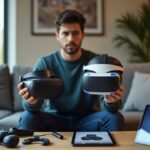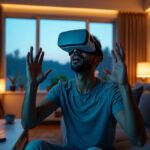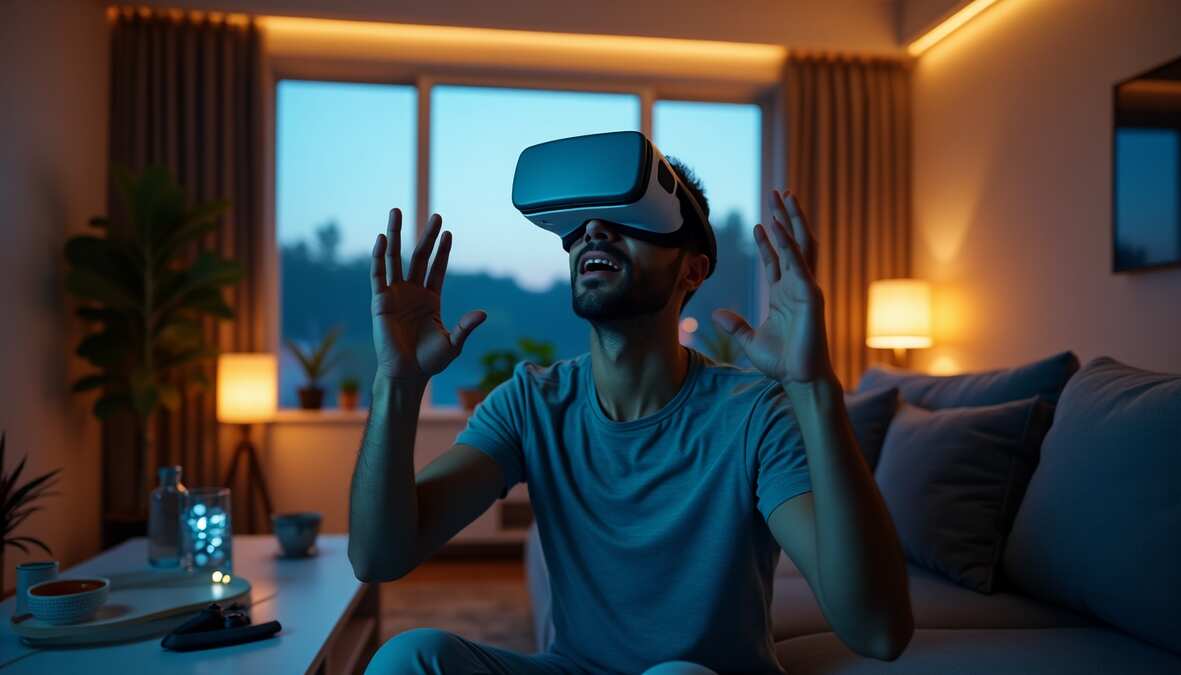VR Experience: The numbers for VR are mind-blowing – 171 million users worldwide and a market that will hit $27 billion. I watched countless reviews and read testimonials before jumping into virtual reality. My casual interest quickly turned into 100 hours spent exploring virtual worlds of all types.
The Meta Quest 3 became my gateway into VR with its impressive 2064 x 2208 resolution per eye. Many people call it the best VR headset 2024 has to offer. Gaming seemed like the main attraction at first, but I found VR’s impact goes way beyond the reach and influence of entertainment. Healthcare, education, and real estate sectors are changing because of this technology.
In this piece, I share my raw 100-hour VR experience – from physical challenges to emotional peaks and valleys, and unexpected things I found along the way. My insights are a great way to get realistic expectations about extended VR use. This applies whether you want to buy your first headset or just want to know how it feels to use VR for long periods.
The First 10 Hours: Falling in Love with VR
I felt like I was opening a piece of the future when I unboxed my Meta Quest 3. The sleek packaging revealed what many think about as the best VR headset 2024 – a gorgeous headset and two alluring controllers that seemed to call out to be picked up. My excitement took over and I put everything together quickly to start what turned into a 100-hour experience through virtual worlds.
Finding the magic of virtual reality
My hands shook a bit as I put on the headset for the first time. That’s when everything changed. The tutorial took me through different virtual environments, and I suddenly had actual depth perception in a digital space. This was different from watching videos on a screen – it felt real. Objects seemed to exist physically as I reached out to grab and throw them around.
Someone who hasn’t tried VR might find it hard to understand this feeling. A VR user put it perfectly: “VR feels like being inside your own imagination”. Your brain goes into a psychological state called “presence” where you know it’s a simulation, but your perception makes it feel as real as anything in the physical world.
This went beyond watching a 360-degree video on my laptop. I was truly inside these virtual spaces. The audio made it even better – sounds came from every direction and made me believe I had been transported somewhere else.
My first ten hours disappeared as I tried different experiences:
- Google Earth VR showed me familiar places from above, giving me a completely new point of view on places I thought I knew well
- Beat Saber mixed music, rhythm, and movement that felt more like interactive dance than a regular game
- The Lab’s “Postcards” helped me adjust to synthetic environments with stunning visuals
- A VR space experience that made me feel like I was floating among stars
Now I understood why VR enthusiasts couldn’t stop talking about this technology. This wasn’t just a screen on my face – it opened doors to places limited only by imagination.
First thoughts on the best VR headset 2024
The Meta Quest 3’s technical capabilities blew me away. Each eye sees through a 2064 x 2208 resolution LCD panel, which creates sharp and detailed visuals. The difference between this and regular screen content jumped out at me right away.
The new pancake lenses make the headset slimmer than the chunky Fresnel lenses in older models. This design makes it more comfortable to wear. The headset doesn’t stick out as much, which really helps during long sessions.
Setting up the Quest 3 surprised me with its simplicity. Unlike other VR systems that need external base stations, I only needed a few steps on the headset and app to get started. This made things much easier as someone new to VR.
The side of the headset has a double-tap feature that quickly shows my surroundings. This solved my worry about being cut off from the real world. The new Touch Plus controllers track perfectly even though they look simpler than previous models.
The mixed reality feature really stood out to me. A quick tap on the headset’s side activates full-color passthrough cameras to show my actual surroundings. This came in handy when I needed to check messages or grab a drink without taking off the device.
VR gaming changed everything about how I see interactive entertainment. Games became places to visit instead of just things to play. This basic change in my point of view turned those first ten hours into some of my most magical gaming moments ever.
After those first sessions, I couldn’t wait to plan my next virtual adventures. My journey had just started, but virtual reality’s possibilities had already won me over.
Physical Challenges: Motion Sickness and Fatigue
The excitement of my first few VR sessions faded as I faced unexpected physical challenges. 40% to 70% of VR users experience motion sickness after just 15 minutes of use. By my third day of exploration, I became part of this statistic.
Dealing with VR motion sickness
Your brain gets mixed signals during VR motion sickness. Your eyes see movement in the virtual world, but your body stays still. This mismatch created a strange discomfort I hadn’t expected.
My symptoms started small while testing a roller coaster simulation:
- Mild dizziness that got worse with quick movements
- A warm feeling followed by cold sweats
- Stomach discomfort that stayed even after I took off the headset
Women, children, older adults, and new VR users feel these effects the most. Notwithstanding that, studies show up to 95% of VR users will feel some “cybersickness” eventually.
Instead of giving up, I found several ways to make it work. Short sessions helped me build what VR fans call “VR legs”. Sitting down during intense movement made things easier.
A simple fan blowing cool air on me worked better than expected. The breeze helped my brain make sense of the mixed signals. Being well-hydrated and avoiding VR after big meals made the symptoms less intense.
Flight simulators were tricky, but looking at one spot in the virtual world helped me stay balanced. My tolerance got better with practice, though I still need to pace myself with certain experiences.
Managing eye strain and physical discomfort
Eye strain became another challenge during long VR sessions. My eyes turned red, dry, and felt gritty. This happened because I blinked less while immersed in virtual worlds.
Research shows the headset creates its own problems. People turn their heads 2.7 times more and use neck muscles 25.9% more in VR compared to desktop computers. This leads to neck discomfort increasing by 60% and shoulder strain by 17.5% after long sessions.
The right headset position made a big difference in reducing neck strain. Eye drops before and after sessions helped with dryness.
Breaking every 30 minutes became my rule. I used the 20-20-20 rule: looking at something 20 feet away for 20 seconds every 20 minutes. This simple change helped my eyes feel better.
My best vr headset 2024’s brightness settings helped reduce eye fatigue. The right interpupillary distance (IPD) settings turned out to be crucial – wrong settings caused immediate strain and blurry vision.
These changes let me enjoy longer VR sessions with less discomfort. Intense experiences still need careful handling, but these preventive steps have made longer explorations both possible and fun.
Emotional Highs and Lows of Extended VR Use
The physical challenges of VR were just the beginning. I found that there was an emotional roller coaster that came with long VR sessions. My emotions moved between incredible highs and unexpected psychological lows – something you rarely see mentioned in product reviews.
Moments of awe and wonder
The powerful emotional responses from certain VR experiences caught me completely off guard. Researchers say awe surpasses normal emotions when we see something so big that our minds need time to process it. This matches exactly what I felt during my vr space experience as I floated among stars and planets with pure childlike wonder.
Research shows VR environments can create an average awe rating of 79.7 on a scale of 0-100. This hit home when I tried a photorealistic underwater scene. Marine life surrounded me and created what scientists call “presence” – that gut feeling that you’re actually there in a simulated world.
These moments did more than just entertain – they changed something deep inside me. Studies show these awe-inspiring moments are a great way to get wellness benefits and boost feelings of connection and life satisfaction. My time with the best vr headset 2024 has to offer left me with:
- Lower stress and anxiety
- Better creativity
- A better mood that lasted hours after taking off the headset
Your brain processes awe in specific regions. The prefrontal cortex lights up while the anterior cingulate cortex helps manage emotional responses. My brain handled these virtual moments just like it would handle amazing real-life events.
Feeling isolated or disconnected after sessions
Long VR sessions sometimes left me feeling oddly detached from reality. One night, after three hours in virtual worlds, I took off my headset and felt weirdly disconnected from my actual surroundings. Research backs this up, showing heavy VR use can lead to “negative rumination” – those harmful thoughts that bring distress.
This wasn’t just in my head. Another VR user put it this way: “I just spent hours painting with fire in a 3D space. I felt like a god… But what stays is a strange feeling of sadness when participating in the real world”. Many users say they feel less connected to people in their physical lives after deep VR sessions.
VR gaming can magnify negative emotions sometimes. Studies comparing VR and laptop users found that VR made negative feelings stronger because users got more absorbed. One study participant said they became “completely unable to hold a conversation” after long sessions.
The emotional effects change based on what you’re doing in VR. Relaxation or social connection programs usually create positive emotional results. Studies show VR helps reduce anxiety in patients getting ready for brain surgery, which shows how this technology could help people.
My 100-hour experience taught me to balance these emotional extremes. I kept sessions shorter and made sure to transition carefully between virtual and physical worlds. This helped me get the good emotional benefits while avoiding that disconnected feeling that sometimes came after intense VR experiences.
Exploring Different VR Worlds: Games, Space, and More
My VR headset opened up a world of endless realities and experiences. The technology took some getting used to, but I soon started to check out different types of content. The variety of virtual worlds left me amazed.
Virtual reality gaming experiences that stood out
VR gaming gave me new ways to play in digital worlds. Beat Saber became my favorite right away. This rhythm game had me slice through glowing cubes as electronic music played. The mix of physical movement and visuals created something you just can’t get on a regular screen.
Half-Life: Alyx showed what top-tier VR gaming can do. The game fits between Half-Life 1 and 2, with amazing graphics and smooth gameplay. I could pick up and handle objects just like in real life. This changed my view of what games could be.
No Man’s Sky blew me away with its size. The game lets you visit endless computer-generated planets, each with its own scenery and creatures. Setting foot on unknown worlds felt amazing, and looking up at strange skies or meeting weird wildlife never got old.
Some other great games included:
- PowerWash Simulator VR – A surprisingly peaceful and fun experience
- Batman: Arkham Shadow – Living out the dream of becoming Batman
- Puzzling Places – Putting together 3D puzzles of real places with unexpected challenges
These games were different from regular gaming because you feel like you’re really there. Instead of using a controller to move characters, you become part of these virtual worlds. Every action feels more real and meaningful.
Trying a VR space experience and Spider Man VR experience
The NASA SLS VR Experience made my childhood dreams of space travel come true. This free program let me stand next to NASA’s huge Space Launch System rocket and look around from different spots. The best part was sitting in the Orion spacecraft cockpit before launch, seeing exactly what astronauts see. Standing next to that massive rocket made me feel tiny.
Spider-Man VR was just as exciting. The Far From Home VR experience brought web-swinging to virtual reality. Shooting webs at buildings and flying through New York streets felt real. The controls made sense – point at a building, shoot a web, and pull yourself forward. The movement felt smooth and natural, just like being Spider-Man.
Yes, it is the feeling of weightlessness that made the Spider-Man experience special. The graphics looked basic (like a PS2 game on PC VR), but the gameplay was so fun that it didn’t matter. I could run up walls, swing with two web lines, and jump off tall buildings. This gave me the superhero experience I always wanted.
These special experiences show how VR can make impossible dreams feel real. Videos and regular games might try to copy these experiences, but VR creates something completely different and more powerful.
I bought my headset thinking games would be the main attraction. But these unique experiences – from space travel to being Spider-Man – turned out to be just as amazing on my VR journey.
Best VR Sites and Experiences I Recommend
I’ve spent countless hours in virtual worlds and want to share some real-life spots where you can try VR without buying your own headset. There are also some amazing experiences that don’t get enough attention.
Top VR experience near me and in Las Vegas
Las Vegas really shines when it comes to top-tier VR experiences. Sandbox VR is 3 years old and has become a favorite spot among VR fans with four dedicated “sandboxes” that host five custom VR adventures. Their full-body tracking technology makes group play an unforgettable experience.
Area 15 is another must-see VR spot in Vegas. This massive “playground” goes beyond just immersive visuals. They add real 4D elements like touch and smell to make everything feel more real. You’ll also find cool attractions like Five Iron Golf, Grand Prix Racing simulators, and the mind-bending Omega Mart.
Teams looking for a challenge will love Virtual Room Las Vegas which blends classic escape room puzzles with VR tech. The MGM Grand VR setup lets eight players jump in together, with games from Zombie Survival to the puzzle-filled Engineerium.
Pole Position Raceway started as an indoor karting place but now they’ve added VR with their Omniverse 2.0 technology. It’s a hidden gem you wouldn’t expect to find at a go-kart track.
Hidden gems: VR experience Seattle and beyond
Seattle’s VR scene has some amazing spots. Dimension XR gives you a huge virtual gaming room that’s perfect for big groups. HIVE Virtual Reality stands out as Seattle’s only private VR space where 2-5 players can game together.
I’ve found some incredible VR experiences beyond these physical locations. VR fans say The Invisible Hours might be the best story-driven experience out there. Paper Beast creates something totally different by mixing Populous-style gameplay with storytelling.
Virtual tourists will love Buzludzha VR which lets you explore fascinating places at your own pace. If you’re into adventure games, try Vengeful Rites – players call it “the closest thing to Zelda VR”.
The Hidden Gems Touch Bundle gives you great value with five indie games at 30% off. You get Sports Bar VR for cross-platform pub games, ZR with its 30+ weapons for survival, BowSlinger where you defend castles from orcs, HoloBall for arcade sports action, and one more creative title.
These games and experiences show just a small part of what’s happening in our fast-changing VR world. Each one brings something special that shows what this technology can do.
What I Wish I Knew Before Starting My VR Journey
My VR experience taught me many lessons I wish someone had shared earlier. Now I can see things clearly and want to help others start their VR trip smoothly.
Tips for first-time users to experience VR better
Your VR journey should start with stationary games like Beat Saber or Job Simulator. These games help you develop your “VR legs” and prevent motion sickness. A round rug in the center of your play area gives you tactile feedback. You’ll always know where you stand without breaking immersion.
A desk fan pointed at your play space serves two vital purposes. It helps curb motion sickness and gives you a constant direction reference point. Stay hydrated during your sessions to avoid discomfort. Take regular breaks every 30 minutes. The 20-20-20 rule works well – look at something 20 feet away for 20 seconds to reduce eye strain.
Motion sickness can be tough. Try using teleportation movement instead of smooth locomotion until you build tolerance. Snap turning works better than smooth rotation to minimize vestibular confusion.
Choosing the right headset and setup for comfort
The Meta Quest 3 gives you great value with standalone capability and PC connectivity. The Quest 3S costs $300 and delivers solid performance. New users unsure about their long-term interest should consider this budget-friendly option.
Before you buy, think over these comfort essentials:
- Interpupillary distance (IPD) adjustment helps with visual clarity and reduces eye strain
- Weight distribution affects your neck’s comfort during long sessions
- Facial interface material determines comfort and hygiene for extended use
Glasses wearers should look for headsets with built-in glasses spacers like the Quest series. Your headset should feel balanced on your face. The pressure should rest on your forehead instead of your nose. This setup works best for those long gaming sessions you’ll end up having.
My 100-hour dive into virtual worlds has transformed my point of view on digital entertainment. The VR experience surpasses regular gaming or media consumption and creates something new that blurs the line between digital and physical reality.
My relationship with virtual reality grew in clear stages. The pure novelty engaged me at first – it felt magical to physically interact with digital objects. The hours added up, and I started to notice subtle nuances of different experiences that affected me both physically and emotionally.
VR isn’t just about escapism. This technology expands what we can achieve in digital spaces. Each session showed me possibilities that traditional media can’t match. I discovered new dimensions through Tilt Brush and relived historical moments through immersive documentaries.
VR technology keeps advancing rapidly. The headsets get lighter, displays become sharper, and tracking grows more precise with each new version. These technical improvements are great, but the core appeal stays the same – you feel genuinely present in another world.
Developers keep expanding creative possibilities, and that’s exciting to watch. VR applications now reach way beyond the influence of gaming into education, therapy, social connection, and artistic expression. The best VR headset 2024 marks just the beginning of this technological rise.
Anyone thinking over their own VR experience should try different types of content. VR is a great fit for almost everyone – from intense fitness games to peaceful virtual tourism. The technology’s greatest strength lies in its adaptability rather than any single use.
These hundred hours in VR weren’t just entertainment. They showed me a glimpse of how we’ll interact with digital content for decades ahead.
FAQs
Q1. How long does it take to get used to VR? It varies for each person, but most users develop their “VR legs” within the first 10-20 hours of use. Starting with stationary games and taking regular breaks can help you acclimate more quickly.
Q2. What are some ways to reduce VR motion sickness? To minimize motion sickness, try using a fan for airflow, starting with shorter sessions, focusing on a fixed point in the virtual environment, and ensuring proper hydration. Teleportation movement and snap turning can also help until you build tolerance.
Q3. Are there any long-term effects of extended VR use? While research is ongoing, some users report temporary effects like eye strain or feeling disconnected from reality after long sessions. Taking regular breaks and limiting session length can help mitigate these issues.
Q4. What types of experiences are available in VR beyond gaming? VR offers a wide range of experiences including virtual tourism, educational simulations, fitness programs, artistic creation tools, and even therapeutic applications. The technology’s versatility extends far beyond just gaming.
Q5. How do I choose the right VR headset for me? Consider factors like your budget, desired features (standalone vs. PC-connected), comfort (weight distribution and IPD adjustment), and the types of experiences you’re most interested in. For beginners, a more affordable option like the Quest 3S might be a good starting point.
Read more: Free Credit Report
![Why Your Computer Network Security Is More Vulnerable Than You Think [2025 Guide] network security](https://vgyr.xyz/wp-content/uploads/2025/04/network-security-1-150x150.jpg)







